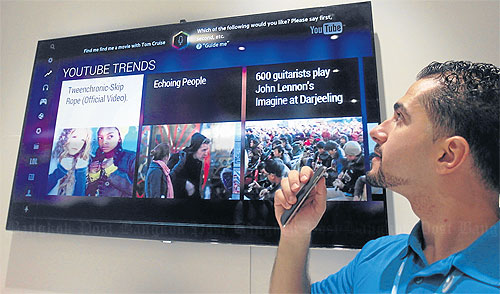
Smart televisions have become even more intelligent, transforming your living room into the ultimate home entertainment and information hub.

A Samsung employee demonstrates the S-Recommendation feature of the 2013 smart TV by speaking into a remote control.
Smart TVs now can take you online, show videos from YouTube, initiate video calls and play your entire media library _ and all in three dimension.
At the International Consumer Electronics Show (CES) 2013 in Las Vegas last week, Samsung unveiled its latest innovative smart TV, promising to use voice and face recognition to let you control your TV without any remote controls.
"This is the future of TV interface," said Tim Baxter, president for consumer electronics at Samsung Electronics America.
Mr Baxter said technologies for smart TV now can understand what users like and make recommendations for them by analysing a user's viewing history and programme popularity before releasing his or her favourite TV programmes.
Samsung developed its recommendation function for its new 2013 smart TV products. It provides personalised menus for on-air, on-demand and application content for each viewer.
Mr Baxter said the changing consumer behaviour of using multiple screens for TV, tablet, notebook or smartphone are driving the explosion in content.
For instance, he noted viewers can search and schedule content on a tablet, view content remotely or mirror the Smart TV on a tablet to take the content with them around the home.
The existing smart TV has the ability to update the new 2013 features by using an evolution kit, a small electronic device attached to the back of the TV.
This is the first time smart TV allows upgradable ability which drives consumers to make buying decisions faster, said Mr Baxter.
Samsung is also introducing its new flagship F8000 LED television, its first quad-core processor television boasting a capacity three times faster than existing ones.
The company also debuted its new OLED TV F9500 model, the world's first TV offering multi-view features, enabling two people to watch different HD content simultaneously on the same screen. This feature is enabled by Samsung's special 3D glasses.
Samsung's 110-inch TV set, touted as the world's largest ultra HDTV, was also the highlight at the CES this year. The product was selected as the best innovative product in 2013.
The Consumer Electronics Association (CEA), the organiser of CES, said ultra HDTV is a key emerging technology trend, with more than 10 companies displaying their products at this year's show.
The CEA forecasts internet-connected TVs or smart TVs will see strong growth this year, with unit sales reaching 12.3 million, up from 9.2 million in 2012.
MarketsandMarkets, the business research firm, forecasts the value of the overall smart TV market will reach $265 billion by 2016, growing at a compound rate of 17%.
Unit shipment will top 153 million units by that year, up from 64 million in 2011 and at a compound rate of 19%.
Android-enabled digital cameras equipped with Wi-Fi connectivity were another highlight at the CES.
Compact cameras increased their ability to compete with smartphones, enabling users to directly send high-resolution photos or clips from Wi-Fi-connected cameras.
It also allows users to share or upload shots and clips on Facebook, Instagram, YouTube and Twitter.
Samsung demonstrated its Galaxy camera featuring the Android 4.1 operating system and 4G connectivity.
The South Korean company also showcased the NX3000, the world's first one-lens 3D system.
It has the capacity to capture both stills and 1080p full HD video in 3D quality.
Polaroid also launched the world's first Android-powered compact interchangeable lens camera with built-in Wi-Fi connectivity.